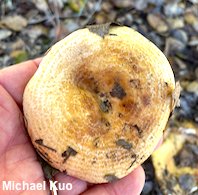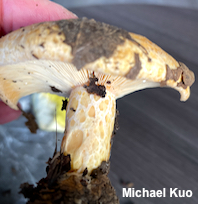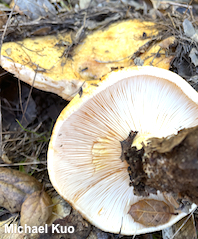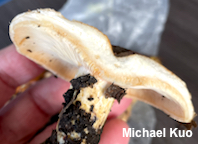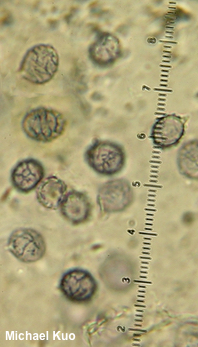Fortunately there are more stable identifying features for this mushroom, including its taste, which is quickly very acrid (excruciatingly so)—and the fact that the milk is white as exuded, and only turns slightly yellow (if at all) on exposure to air. These features should help separate Lactarius alnicola from Lactarius xanthogalactus, which also associates with coast live oak, since it has milk that consistently turns darker yellow, and a slowly, slightly acrid taste.
In today's DNA-informed context, it is very unlikely that a mycorrhizal species would associate both with coast live oak and conifers. And it must be said that even careful collectors can make mistakes documenting mycorrhizal hosts, since the old-school "drip line" theory of association is often relied upon. But a mycorrhizal mushroom can be much farther away from its host tree than within the circle around the tree where rain could drip. A better gauge is the "toppling distance" of the tree: the circle created by the height of the tree, circumscribed on the ground around its base. In California's mixed coastal forests, this means that a massive Douglas-fir might be the host although it is literally 200 feet away.
My point is that host documentation is not as simple as is often assumed, and that rigorous documentation of many collections, using "toppling range" as a gauge, would be required before declaring a host (or hosts) based on the common denominator trees in the collections. Are you a mycology grad student in California? Thesis idea! I can start your ball rolling with the described and illustrated collection, which could only have been associated with coast live oak or Monterey pine; Melissa and I carefully looked for all trees within toppling range.
Description:
Ecology: Mycorrhizal with coast live oak and/or possibly with conifers; growing alone or gregariously; fall and, in warm climates, winter; originally described from Idaho (Smith in Hesler & Smith 1960); distributed (probably as a species group; see discussion above) in the Pacific Northwest, the Rocky Mountains, and in Michigan. The illustrated and described collection is from Santa Cruz County, California.
Cap: 5–10 cm; convex with an inrolled and slightly hairy margin when young, becoming shallowly vase-shaped, with the margin uplifted and smoother; sticky when young, but soon dry; bald or somewhat fibrillose-rugged; orangish yellow to yellowish orange; with faint to prominent concentric zones of color.
Gills: Beginning to run down the stem; close; short-gills frequent; whitish, stained slowly brownish by the milk.
Stem: 2–5 cm long; 1–1.5 cm thick; equal; with shallow, yellowish to brownish potholes (but see comments above regarding variability); colored like the cap; hollowing with age; basal mycelium white.
Flesh: Whitish; firm; stained slowly yellowish to orangish when sliced.
Milk: White as exuded; turning slowly slightly yellowish when exposed to air.
Odor and Taste: Odor not distinctive; taste strongly peppery-acrd.
Microscopic Features: Spores 7–9 x 5–7 µm; ellipsoid; ornamentation consisting of amyloid ridges and warts up to 0.5 µm high, forming broken reticula. Basidia 30–38 x 6–7 µm; subclavate; 4-sterigmate. Hymenial macrocystidia not found. Pileipellis an ixocutis; yellowish in KOH.
REFERENCES: (Hesler & Smith, 1960; Hesler & Smith, 1979; Arora, 1986; Phillips, 1991/2005; Methven, 1997; Siegel & Schwarz, 2016; Wood & Stevens, 2024.) Herb. Kuo 01112403.
This site contains no information about the edibility or toxicity of mushrooms.

